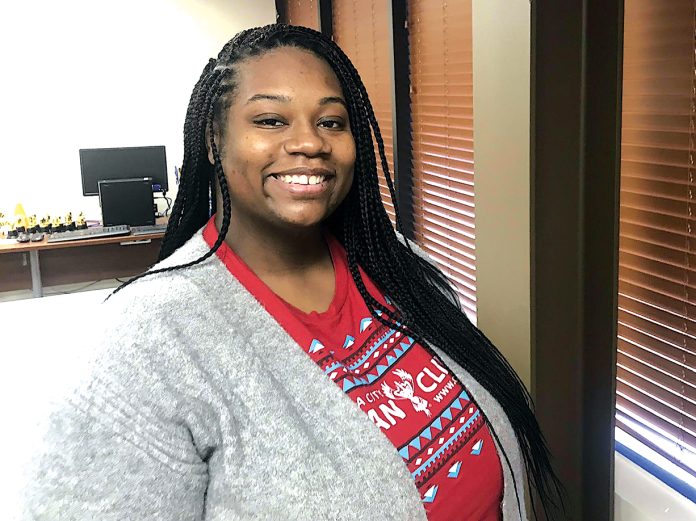
Story and photo by James Coburn, Staff Writer
The Oklahoma City Indian Clinic is one of the top Indian clinics in the United States because of the services they provide. So much of n success is due to the fine staff of caring nurses working there.
Chanaya Andrews, an LPN at the Oklahoma City Indian Clinic became a licensed practical nurse after her grandfather was hospitalized on the oncology floor at SSM St. Anthony Hospital in Oklahoma City. (story continues below)
https://oknursingtimes.com/jobs/job/nursing-positions-available-now-at-brookwood-skilled-nursing-therapy/
“I just remember how the nurses took care of him. They took care of us too, as a family,” Andrews said. “And I never realized how much a nurse does, everything they do behind the scenes after he passed away. It inspired me to get into the medical field.”
She graduated from Moore Norman Technology Center.
“I always say that if anybody is looking for a really good LPN school, that’s where you should go,” Andrews said.
Andrews began her career during the COVID pandemic. She was familiar with the Oklahoma City Indian Clinic from the mock interviews conducted in nursing school. She interviewed with the Oklahoma City Indian Clinic and has worked there for nearly two years.
The Oklahoma City Indian Clinic stood out for her because the staff thrives in their mission of care.
“The vision is to be the national model for American Indian health care. Our mission is to provide excellent care to American Indians. So that’s what we prove. We want to be the best in Indian health services in the United States,”
said Tracee Barton, RN, vice president of nursing. Barton earned a Master of Science in Nursing degree from Southwestern Oklahoma State University.
The Oklahoma City Indian Clinic is constantly making improvements reflecting community needs. The clinic recently purchased a building in Oklahoma City off Southwest 44th and Western. It is in the development process to serve as a clinic for women and children.
But the clinic’s work is not confined to a building. Andrews likes all the volunteer opportunities available with her job.
“We go out into the community. So that was something that really drew me to the Indian Clinic,” Andrews continued. “It touches my heart because we are able to give to those that really need it.”
American Indians can go to the Oklahoma City Indian Clinic for behavioral health services, health promotion, disease prevention, public health, optometry, dentists, urgent care, respiratory care, physical therapy, a wellness center, diabetes education classrooms and the expanded Harmon-y Pediatric clinic.
Women can come to the clinic for mammograms without having to worry if they have health insurance, Andrews said.
“Maybe we can catch something early so we can get it treated,” she added.
The clinic provides preventative care without the additional stress of the client not having a copay at that moment, Andrews said.
Andrews didn’t realize how much of the Oklahoma City homeless community is Native American. The Oklahoma City Indian Clinic helps homeless Native Americans who come there needing clothing and shoes.
“With foot care, you don’t realize how much you need your feet and how good of care you need to keep of your feet,” she explained. “And, if you’re homeless, you’re not able to get that care a lot of times if you don’t have insurance. With the Indian Clinic and all the things, they can get done.
Andrews works as a float nurse. So, whenever she goes to the Metabolic Clinic she will provide education, especially about diabetes. Her focus depends on where she is in the clinic.
Nw nurses need not worry about asking questions to the staff. Leadership and staff members take time to listen to concerns, she said. A well-rounded nurse at the Oklahoma City Indian Clinic needs the qualities of integrity and commitment, Andrews said.
“I have to say be a personable person, truthful, and I think having empathy definitely is needed to work here,” she continued.
Being a nurse helps Andrews not to take what she sees on a surface value. There is a lot more in a person’s life happening behind the scenes, she said. She worked in food services before becoming a nurse. Andrews would encounter people with an attitude or anger.
“In healthcare they might bring those things, too. But a lot of times, there’s a lot of stuff going on behind the scenes,” she said. “Maybe you get a call and there is something going on and they’re already frustrated,” she said. “You didn’t do anything, but maybe they are calling about a pap smear result. They want to know because they have a family history of cervical cancer. So, I think nursing has helped me to not just see what I see right now — but understand the picture of it.”
For more information about the Oklahoma City Indian Clinic visit: http://okcic.com/












